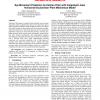Free Online Productivity Tools
i2Speak
i2Symbol
i2OCR
iTex2Img
iWeb2Print
iWeb2Shot
i2Type
iPdf2Split
iPdf2Merge
i2Bopomofo
i2Arabic
i2Style
i2Image
i2PDF
iLatex2Rtf
Sci2ools
118
click to vote
ETRA
2008
ACM
2008
ACM
Eye movement prediction by Kalman filter with integrated linear horizontal oculomotor plant mechanical model
The goal of this paper is to predict future horizontal eye movement trajectories within a specified time interval. To achieve this goal a linear horizontal oculomotor plant mechanical model is developed. The model consists of the eye globe and two extraocular muscles: lateral and medial recti. The model accounts for such anatomical properties of the eye as muscle location, elasticity, viscosity, eyeglobe rotational inertia, muscle active state tension, length tension and force velocity relationships. The mathematical equations describing the oculomotor plant mechanical model are transformed into a Kalman filter form. Such transformation provides continuous eye movement prediction with a high degree of accuracy. The model was tested with 21 subjects and three multimedia files. Practical application of this model lies with direct eye gaze input and interactive displays systems as a method to compensate for detection, transmission and processing delays. CR Categories: I.6.4 [Simulation a...
| Added | 19 Oct 2010 |
| Updated | 19 Oct 2010 |
| Type | Conference |
| Year | 2008 |
| Where | ETRA |
| Authors | Oleg Komogortsev, Javed I. Khan |
Comments (0)

